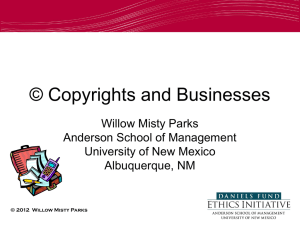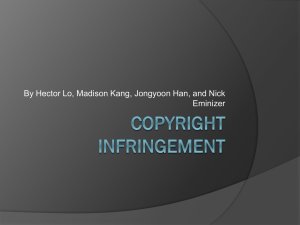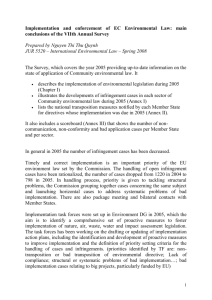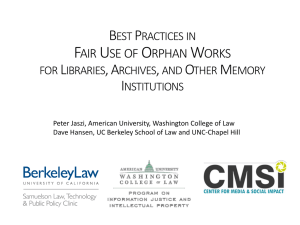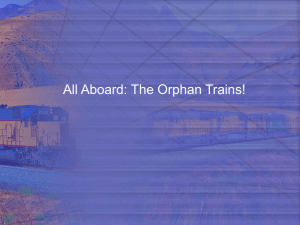Volume 1, No. 4 - Mississippi Law Research Institute
advertisement
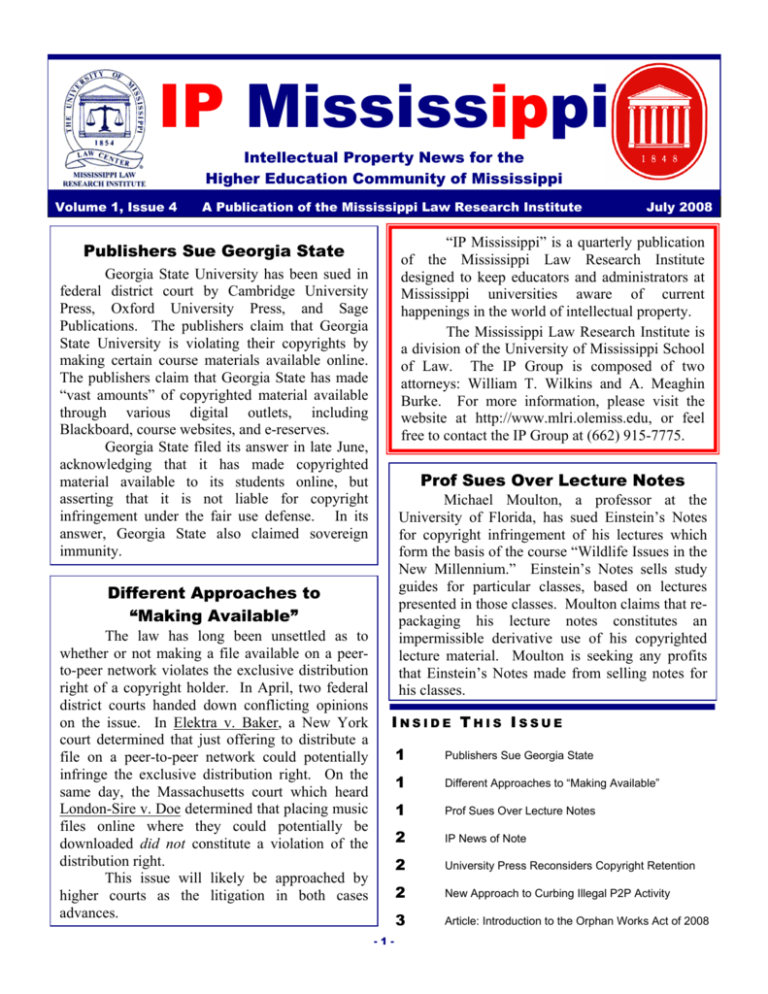
IP Mississippi Intellectual Property News for the Higher Education Community of Mississippi Volume 1, Issue 4 A Publication of the Mississippi Law Research Institute “IP Mississippi” is a quarterly publication of the Mississippi Law Research Institute designed to keep educators and administrators at Mississippi universities aware of current happenings in the world of intellectual property. The Mississippi Law Research Institute is a division of the University of Mississippi School of Law. The IP Group is composed of two attorneys: William T. Wilkins and A. Meaghin Burke. For more information, please visit the website at http://www.mlri.olemiss.edu, or feel free to contact the IP Group at (662) 915-7775. Publishers Sue Georgia State Georgia State University has been sued in federal district court by Cambridge University Press, Oxford University Press, and Sage Publications. The publishers claim that Georgia State University is violating their copyrights by making certain course materials available online. The publishers claim that Georgia State has made “vast amounts” of copyrighted material available through various digital outlets, including Blackboard, course websites, and e-reserves. Georgia State filed its answer in late June, acknowledging that it has made copyrighted material available to its students online, but asserting that it is not liable for copyright infringement under the fair use defense. In its answer, Georgia State also claimed sovereign immunity. Prof Sues Over Lecture Notes Michael Moulton, a professor at the University of Florida, has sued Einstein’s Notes for copyright infringement of his lectures which form the basis of the course “Wildlife Issues in the New Millennium.” Einstein’s Notes sells study guides for particular classes, based on lectures presented in those classes. Moulton claims that repackaging his lecture notes constitutes an impermissible derivative use of his copyrighted lecture material. Moulton is seeking any profits that Einstein’s Notes made from selling notes for his classes. Different Approaches to “Making Available” The law has long been unsettled as to whether or not making a file available on a peerto-peer network violates the exclusive distribution right of a copyright holder. In April, two federal district courts handed down conflicting opinions on the issue. In Elektra v. Baker, a New York court determined that just offering to distribute a file on a peer-to-peer network could potentially infringe the exclusive distribution right. On the same day, the Massachusetts court which heard London-Sire v. Doe determined that placing music files online where they could potentially be downloaded did not constitute a violation of the distribution right. This issue will likely be approached by higher courts as the litigation in both cases advances. July 2008 INSIDE THIS ISSUE -1- 1 Publishers Sue Georgia State 1 Different Approaches to “Making Available” 1 Prof Sues Over Lecture Notes 2 IP News of Note 2 University Press Reconsiders Copyright Retention 2 New Approach to Curbing Illegal P2P Activity 3 Article: Introduction to the Orphan Works Act of 2008 IP News of Note • In February 2008, the Arts and Sciences Faculty at Harvard adopted an open-access policy that provided for and encouraged the publication of faculty’s scholarly works on a publicly accessible website. Faculty at Harvard Law School have announced similar plans to produce an open-access repository for faculty research and publications. • Blackboard and Desire2Learn, two competing providers of course management software, have returned to court, just months after Desire2Learn was found liable for infringing several of Blackboard’s patents and a federal court enjoined Desire2Learn against further patent infringement. Blackboard now claims that Desire2Learn has failed to comply with the court’s injunction by refusing to design around the infringing elements. • The University of Iowa has abandoned its plans to make students’ theses available online. The plan was met was met with protests by students who felt that the potential commercial value of their work could have been diminished by the proposed open access. • The United States Congress is currently considering two bills which would extend copyright protection to fashion designs. These proposed Design Piracy Prohibition Acts have drawn attention as lawmakers debate whether copyright or patent is the most effective means of protecting fashion designs. The House Subcommittee on Courts, the Internet, and Intellectual Property held a hearing in February 2008 to gather information on how best to protect the fashion industry. • The House of Representatives passed the PRO-IP Act by a huge margin in May 2008. The controversial bill would increase penalties for copyright infringement and would also establish a copyright enforcement division of the Justice Department. The bill has been strongly supported by the Motion Picture Association of America and the Recording Industry Association of America. University Press Reconsiders Copyright Retention Rockefeller University Press, a nonprofit press which publishes three scientific journals, now allows authors to retain the rights to articles published in its journals. The authors are permitted to reuse their works for any purpose; the press does require that each subsequent use include attribution to the journal where the article was originally published. Third parties are permitted to reuse the works without Rockefeller University Press’s permission, so long as the use is noncommercial and the original source is attributed. This policy is noteworthy because most scientific journals require authors to release all copyright interests to the publisher as a condition for publication. New Approach to Curbing Illegal P2P Activity Missouri University of Science and Technology has implemented a new strategy in the fight to block illegal fire sharing by students. Missouri S & T requires that any on-campus user of a peer-topeer network pass an online quiz testing the user’s knowledge of copyright law. The quiz must be taken (and passed) every time a peer-to-peer network is accessed. Since the protocol has been put in place, Missouri S & T has seen a dramatic reduction in the number of Digital Millennium Copyright Act takedown notices. -2- INTRODUCTION TO THE ORPHAN WORKS ACT OF 2008 A bill is currently being considered in the United States Senate which would impact the judicial remedies available to certain copyright owners if their works are infringed. The bill, S. 2913, is known as the Shawn Bentley Orphan Works Act of 2008, and it was introduced on April 24, 2008, by Senator Patrick Leahy. The bill was referred to the Committee on the Judiciary. On May 15, 2008, the Committee on the Judiciary passed the marked-up bill out of Committee. Many groups have reacted strongly to the proposed legislation. The American Society of Media Photographers (ASMP) has denounced the bill as lacking enough protection for professional photographers’ works and has announced that it will not support the Senate version of the bill. ASMP does, however, support H.R. 5889, the version of the Orphan Works Act originating in the House of Representatives, which is currently being considered by the House Committee on the Judiciary. Public Knowledge, a public interest group concerned with digital rights, has come out in support of both the Senate and House bills. The Motion Picture Association of America and the Recording Industry Association of America have also come down in favor of the legislation. Photo Business Forum, American Association of Independent Music, and Illustrator’s Partnership have decided not to support the bills, citing inadequate protection of artists’ rights. The bill would add several provisions to the end of Chapter 5 of the U.S. Copyright Code – the chapter which details the remedies available to those who have copyrights that are infringed. The bill’s stated purpose is “to provide a limitation on judicial remedies in copyright infringement cases involving orphan works.” Orphan works are copyrighted works where the owner is unknown or difficult to contact. The impact of the bill, therefore, would appear to be to reduce the amount of damages available to the owner of an orphan work that is infringed. Alternatively, the law can be seen to provide further legal protection to an infringer of an orphan work. Conditions for Eligibility The bill first sets out the conditions for eligibility that must be met in order for an infringer of an orphan work to fall under the umbrella of protection set out by the rest of the bill. An infringer is eligible to claim protection under the limited judicial remedies if he meets each of six requirements. Three of the requirements are pre-litigation hurdles that must be cleared, and three of the requirements are particular litigation processes that must be implemented. The three pre-litigation hurdles, to be located at Sec. 514(b)(1)(A)(i)-(iii), are: 1. The infringer (or his agent) must have performed and documented a “qualifying” good faith search for the owner of the copyright, and the infringer must have been unsuccessful in locating the owner of the infringed copyright. A search “ordinarily qualifies” if the infringer makes a diligent effort. An effort’s diligence will be examined by, according to Sec. 514(b)(2)(A)(i), looking to best practices, the reasonableness and appropriateness of the actions, and whether the action was undertaken before the infringement. 1 The use of resources for which a charge is imposed may be necessary, under the circumstances, to implement a diligent effort. 1 Before the most recent proposed amendment to the bill, the bill included a section which outlined a three-factor test for courts to employ when considering the diligence of a search. The courts were instructed, in 514(b)(2)(A)(ii), to consider whether (1) the infringer’s search was reasonable and appropriate, (2) the search used “best practices” as established by the Register of Copyrights, and (3) the infringer conducted the search before using the work. -3- 2. The infringer must have provided attribution to the owner in a reasonable manner. 3. The infringer must have included a symbol or notice of the use, as prescribed by the Register of Copyrights. The three litigation requirements, to be located at Sec. 514(b)(1)(A)(iv)-(vi), are: 1. The infringer must assert the judicial remedy limitations provided by the Orphan Works Act in the initial pleading. 2. The infringer must either be within the jurisdiction of the United States district court, or must consent to such jurisdiction. 3. The infringer must state with particularity the basis for the right to claim the limitations during initial Rule 26 discovery disclosures. If an infringer is given notice of the claim for infringement and fails to negotiate reasonable compensation in good faith or fails to render payment of reasonable compensation in a timely manner, then the infringer can no longer assert the limitations provided by the Orphan Works Act. Limitations on Remedies The Orphan Works Act provides limitations on remedies in two general categories: monetary limitations and injunctive limitations. 1. Monetary relief is limited in Sec. 514(c)(1). Generally, monetary relief may not be ordered except to require the infringer to pay reasonable compensation to the owner of the copyright. An order requiring the infringer to pay reasonable compensation may not be made, however, if the infringer is (1) a nonprofit educational institution, museum, library, archive, or public broadcasting entity and (2) the infringer proves that the infringement was undertaken without the goal of receiving commercial advantage; the nature of the infringement was mostly educational, religious, or charitable; and the infringer promptly ceased the infringement after receiving notice of the claim for infringement. 2 2. Injunctive relief is limited in Sec. 514(c)(2). Generally, the court may impose injunctive relief to prevent or refrain copyright infringement. An exception is provided to the general rule. If the infringer has prepared (or started to prepare) a work that transforms or integrates the infringed work, any court-ordered injunctive relief may not restrain the infringer’s continued use of the work if (1) the infringer pays reasonable compensation to the owner of the infringed work; and (2) the infringer provides attribution, if requested by the owner. 514(c)(2)(C) provides more wrinkles to the injunction limitations. The limitations on injunctive relief are not available if the infringer asserts in the civil action that he is not subject to suit in United 2 The original bill provided that if a nonprofit educational institution, museum, library, archive, or public broadcasting entity earns money directly attributable to the use of the infringed work, the institution would be responsible for paying the copyright owner the portion of proceeds attributable to the infringement. -4- States courts for copyright infringement, unless the court finds that the infringer (1) has complied with the six requirements of eligibility and (2) has made an enforceable promise to pay reasonable compensation to the copyright owner. General Provisions The bill provides a rule of construction in 514(c)(2)(D) so that the law will not be construed to authorize or require or constitute an authorization to sue a state. The bill also states that no action taken by the infringer under 514(c)(2)(C) shall be deemed a waiver of rights or privileges by the infringer. The bill then indicates that no other rights, limitations, or defenses to copyright infringement are affected by the Orphan Works Act. Also, the Orphan Work Act does not supersede other provisions of the Copyright Code that provide for statutory licenses. Further, an infringer who satisfies the requirements for limitation of remedies under this law shall not be denied copyright protection in a compilation or derivative work on the basis that the compilation or derivative work employs material that has been used unlawfully under the Orphan Works Act. The amended bill also contains a provision that would make the limitations on remedies unavailable to an infringer who infringed the copyright by fixing a pictorial, graphic, or sculptural work on a “useful article” that is sold or distributed to the public. Section 3 of the Orphan Works Act requires the establishment and maintenance of an electronic database by the Register of Copyrights that will facilitate the search for pictorial, graphic, and sculptural works that are subject to copyright protection. Section 5 requires that the Register of Copyrights conduct a study of small copyright claims with an eye towards devising alternative means of resolution. The Comptroller General of the United States is also required under the bill to examine the deposit requirement in the copyright registration system and notify Congress about his findings. The law would go into effect no earlier than January 1, 2009, and no later than January 1, 2013. If the Copyright Office announces that it has certified two searchable electronic databases between those two dates, the law would go into effect thirty days after such notice is published. The law would apply to infringing uses that commenced after the effective date. -5-
